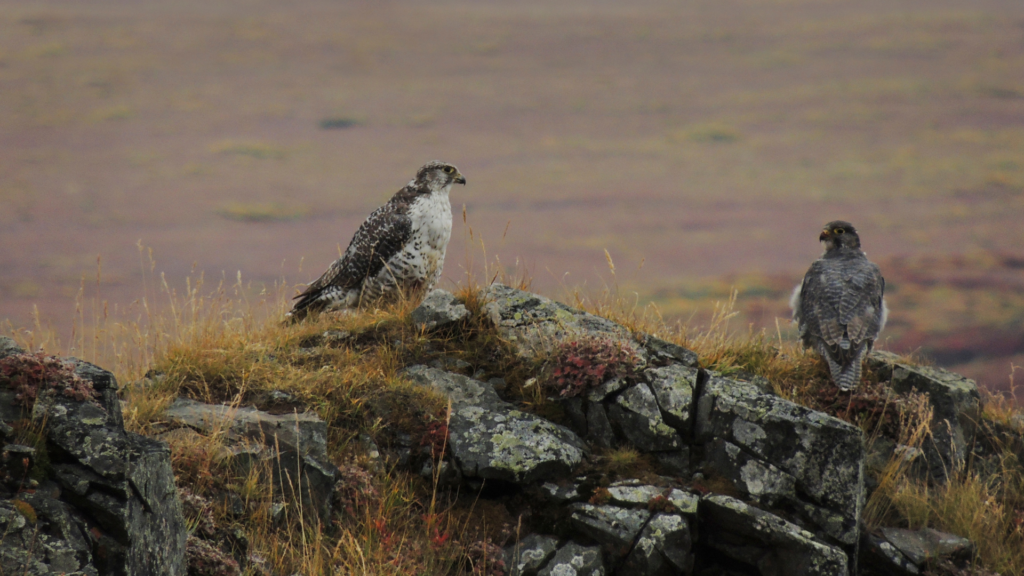by Jennea Frischke
A variety of birds migrate to Alberta from the Arctic each winter – including 3 very special raptors: the snowy owl, the gyrfalcon, and the rough-legged hawk. They call the Arctic home for the summer months where they raise their offspring and migrate south once when prey becomes scarce on the tundra in the winter. These raptors can be found in Alberta from November to April, creating a unique opportunity for birdwatching.
Here’s some facts about these amazing birds, and tips on how to view them in the wild.
Snowy Owl

- These majestic white owls are one of the larger North American owls – standing at nearly half a meter tall, with a wingspan of almost 1.5 meters. Adult male owls are usually pure white in colour, while females are darker with feathers barred with dark brown.8
- Unlike most other owls, the snowy owl is diurnal (active during the day) rather than nocturnal.
- In the summer, they can be spotted on the tree line in Arctic Canada, and on the high, rolling tundra with tall points of land for nests and perches.8
- The snowy owl diet is made up of small rodents, rabbits, birds, and fish. Their favorite summer meal is lemmings, and they can eat up to four a day!5

For birders: Look in open areas. Snowy owls are often seen on top of telephone poles, farm irrigation, or fences. They’re sometimes found sitting in the middle of fields looking a bit like a large lump of snow.
Fun Fact: The circle of feathers surrounding a snowy owl’s eyes helps reflect sound to its ears; a feature that comes in handy when vision is limited.8
Gyrfalcon

- These striking raptors are the largest falcon species in the world! They’re also one of the fastest, reaching up to 80 kilometers per hour in level flight! They weigh one to two kilograms, with their wingspan often reaching over a meter. There are three colour morphs of gyrfalcon: white, gray, or dark.6
- Not all gyrfalcons migrate, and ones that live in lower arctic areas are only partially migratory, meaning some may migrate while others remain in their territories year-round.6 They tend to nest in rocky ledges and cliffs, not building their own nest, but instead using the cliff shelf as a nest.6
- Like other falcons, they mostly prey on other birds. Their preference is to hunt ground birds such as ptarmigan and grouse, but also prey on seabirds and waterfowl, as well as land mammals such as ground squirrels, lemmings, voles, & hares.6
- They can take down prey two times their body weight and have been known to hunt loons and geese.

For birders: Gyrfalcons are used to perching on the ground, so don’t just search the skies—be sure to scan open stretches of ground, where they may be standing at rest or sheltering next to a rock or shrub.4 During migration, some Gyrfalcons are known to pass through small settlements or towns.
Fun Fact: Historically, this bird has been used often in falconry, and kings would only hunt with a gyrfalcon.6
Rough-legged Hawk

- These large hawks (46 to 55 centimeters tall) are named for their feathered legs, that help conserve heat.9 They are one of only three American raptors that have legs feathered all the way to the toes (the others being the ferruginous hawk, and the golden eagle).
- These birds come in light and dark morph color variations. Light-morph birds have a light head, and a dark belly band, with black patches on the wings, and a white tail with a dark terminal band. Dark-morph birds are dark throughout, except for silvery flight feathers on the undersides of their wings. (9)
- Male rough-legged hawks are often darker coloured than females. These hawks are monogamous, and pairs raise only one brood per year.9 Rough-legged hawks nest on cliffsides, and lay clutches of three to seven eggs. Replacement clutches are sometimes laid, particularly if the first clutch is lost before hatching. Fledglings often remain near the nest and are dependent on their parents until migration begins.9

For birders: They come from the tundra, an area with few trees, so prefer to be around open habitats, such as fields and airports. These species will often perch in trees, on telephone poles and bales.2 They are one of a few Albertan raptors known to hover in place, along with the American kestrel1 and the northern harrier.10
Fun Fact: They are one of only three American raptors that have legs feathered all the way to the toes (the others being the ferruginous hawk, and the golden eagle).
References
- https://www.allaboutbirds.org/news/raptors-of-winter/
- https://prairiebirder.wordpress.com/2016/01/09/birding-in-the-winter/
- https://www.allaboutbirds.org/guide/Rough-legged_Hawk/overview
- https://www.allaboutbirds.org/guide/Gyrfalcon/
- https://hikebiketravel.com/the-search-for-snowy-owls-in-alberta/
- https://hawkwatch.org/raptor-id/raptor-id-fact-sheets/gyrfalcon/
- https://peregrinefund.org/explore-raptors-species/falcons/gyrfalcon
- https://www.natureconservancy.ca/en/what-we-do/resource-centre/featured-species/birds/snowy-owl.html
- https://www.hawkmountain.org/raptors/rough-legged-hawk
- https://www.allaboutbirds.org/guide/Northern_Harrier/id




